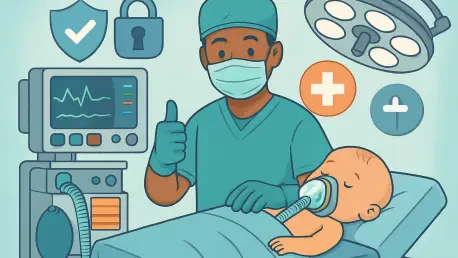Imagine a scenario where a child undergoes surgery, and the anesthesiologist receives a critical alert about a potential oxygen drop 60 seconds before it becomes life-threatening, thanks to the power of artificial intelligence (AI) in pediatric anesthesia. This is no longer a distant dream but a reality shaping the future of medical care for young patients. The integration of AI into this specialized field marks a groundbreaking shift, promising enhanced safety and precision during delicate medical procedures for children. Children present unique challenges due to their varying anatomies and the high-stakes nature of anesthesia, where even minor errors can have severe consequences.
These challenges often stem from the fact that pediatric patients differ significantly from adults, requiring tailored approaches to dosing, monitoring, and equipment use. Anatomical differences, even among children of the same age, complicate standard protocols, making precision paramount. AI offers a solution by analyzing vast datasets to predict risks, monitor vital signs in real time, and personalize care to an unprecedented degree.
The central question driving this innovation is how AI can support anesthesiologists in navigating these complexities. Through predictive algorithms, continuous data analysis, and individualized care plans, AI is emerging as a vital tool to improve outcomes. This technology aims to reduce complications and ensure safer surgical experiences for children, addressing long-standing gaps in traditional methods.
Background and Importance of AI in Pediatric Anesthesia
Pediatric anesthesia stands apart from adult care due to the intricate balance required to manage smaller, more variable physiologies. A slight miscalculation in drug dosage or equipment sizing can lead to critical issues, underscoring the need for exactness and adaptability. Unlike adult patients, children often cannot articulate discomfort or pain, adding another layer of difficulty in monitoring and response.
Historically, anesthesiologists have relied on conventional techniques, such as manual calculations for dosing and subjective scales for pain assessment. These methods, while effective to a degree, often fall short with delayed alerts for emergencies like oxygen desaturation or inconsistent pain evaluations. Such limitations can heighten risks during procedures, leaving room for preventable errors that impact young patients’ safety.
The significance of AI in this context lies in its potential to transform outcomes by minimizing these risks. By enhancing precision and enabling early intervention, AI not only improves patient safety but also advances the broader field of precision medicine. Additionally, it fosters trust among parents, alleviating anxiety during surgeries, and sets a new standard for data-driven care in pediatric healthcare settings.
Research Methodology, Findings, and Implications
Methodology
A comprehensive systematic review, presented at a prominent anesthesiology meeting this year, explored AI applications in pediatric anesthesia by analyzing 10 distinct studies. This rigorous approach synthesized data on how AI tools enhance clinical practices, focusing on their integration into real-world scenarios. The review aimed to assess the technology’s effectiveness across various critical areas of care for young patients.
The methodology involved deploying machine learning models trained on extensive datasets, including real-time inputs from anesthesia machines and patient-specific records. These models were designed to predict complications, optimize equipment use, and support decision-making. Notably, datasets encompassed over 13,000 surgeries for oxygen level monitoring and records from 37,000 children to refine breathing tube sizing, ensuring robust and representative findings.
Data integration played a pivotal role, combining historical surgical outcomes with live monitoring metrics to train AI systems for accuracy. This approach allowed researchers to simulate and evaluate AI performance against traditional standards, providing a clear benchmark for improvement. The emphasis on large-scale, diverse data underscores the potential for scalable solutions in clinical environments.
Findings
The review revealed striking advancements in AI’s capabilities, particularly in predicting critical events like oxygen desaturation. AI models demonstrated the ability to foresee these events up to 60 seconds before standard alarms, offering anesthesiologists a crucial window for intervention. This early warning system significantly outpaces conventional monitoring, which often alerts only at the onset of a crisis.
In postoperative pain assessment, AI achieved a remarkable 95% accuracy rate, surpassing traditional tools like the FLACC and Wong-Baker scales, which range from 85% to 88%. By analyzing subtle behavioral cues and physiological markers, AI provides a more reliable measure of pain in children who may struggle to communicate. This improvement ensures better pain management and recovery experiences post-surgery.
Another key result was a 40% to 50% reduction in errors related to breathing tube size and placement when using AI compared to age- or height-based formulas. These conventional methods often fail to account for individual anatomical differences, whereas AI leverages extensive data to tailor recommendations. Such precision minimizes risks of airway injuries and enhances overall procedural safety.
Implications
AI’s predictive and real-time monitoring strengths have the potential to redefine safety benchmarks in pediatric anesthesia. By identifying risks before they escalate, this technology could prevent life-threatening complications through timely actions, fundamentally altering how emergencies are managed. The impact on patient survival and recovery rates could be profound with widespread adoption.
On a clinical level, integrating AI necessitates training for anesthesiologists to interpret and act on AI-generated insights while preserving human judgment. This balance ensures that technology supports rather than supplants expertise, maintaining the critical role of medical professionals. Hospitals and training programs must adapt to equip staff with skills for this evolving landscape.
Beyond the operating room, AI’s benefits extend to societal levels, boosting parental confidence in surgical safety for their children. It also propels healthcare toward personalized, data-driven practices, aligning with modern medical trends. As trust in technology grows, it could encourage broader acceptance of innovative tools across various medical fields, reshaping patient care standards.
Reflection and Future Directions
Reflection
The systematic review process highlights a measured optimism about AI’s role in pediatric anesthesia, viewing it as a supportive aid rather than a standalone solution. While the technology shows immense promise, its implementation must be approached with caution to ensure reliability and effectiveness in diverse clinical settings. This balance between innovation and prudence remains a guiding principle.
Challenges persist, including the need to validate algorithms for consistency and eliminate potential biases that could skew outcomes. Ethical considerations, such as patient data privacy and the risk of over-reliance on machines, also warrant careful scrutiny. These hurdles emphasize the importance of ongoing oversight as AI integrates into medical practice.
The scope for further research is vast, particularly in extending studies to underrepresented patient groups and evaluating long-term impacts of AI-assisted care. Addressing these gaps will strengthen the technology’s credibility and applicability. The review serves as a foundation for deeper exploration, urging a commitment to refining AI tools for maximum benefit.
Future Directions
Expanding AI applications to other facets of pediatric anesthesia, such as precise drug dosing and recovery monitoring, presents a promising avenue for research. These areas, critical to comprehensive care, could benefit from tailored algorithms that adapt to individual needs. Investigating such uses could further elevate safety and efficacy standards.
Current limitations, including the need for validation across varied healthcare environments, must be tackled through targeted studies. Ethical concerns surrounding data use and decision-making authority also require resolution to build trust in AI systems. Collaborative efforts between technologists and clinicians can help address these barriers effectively.
Seamless integration into routine practice demands standardized protocols and dedicated training programs for medical staff. Research should focus on developing frameworks that ensure AI tools are user-friendly and complement existing workflows. Establishing such guidelines will facilitate adoption and maximize the technology’s impact on pediatric care delivery.
The Future of AI in Pediatric Care
Looking back, the systematic review underscored AI’s transformative power in pediatric anesthesia, demonstrating its capacity to enhance safety, precision, and personalized treatment. The ability to predict complications early, improve pain assessments, and refine equipment use marked significant strides in elevating care standards. These findings laid a critical foundation for rethinking how technology supports medical practice.
Moving forward, actionable steps include accelerating the development of user-friendly AI systems tailored to clinical needs, ensuring they integrate smoothly into hospital settings. Investment in training initiatives for anesthesiologists will be essential to bridge the gap between innovation and application. Additionally, fostering interdisciplinary partnerships can drive solutions to ethical and technical challenges.
As a final consideration, establishing global benchmarks for AI validation and use in pediatric care could harmonize practices and ensure equitable access to these advancements. Encouraging pilot programs in diverse regions will test adaptability and uncover unique needs. With these efforts, AI stands poised to act as an indispensable “co-pilot” for anesthesiologists, preserving the human touch while revolutionizing healthcare outcomes for children.









